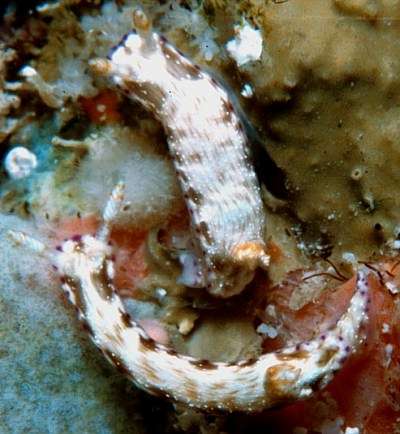
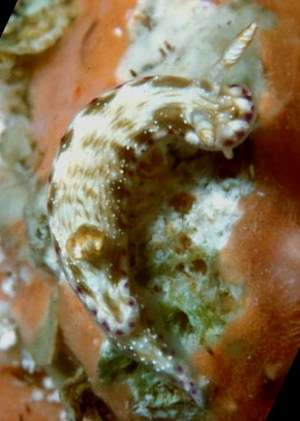
Hypselodoris sp. 2.
Order: NUDIBRANCHIA
Suborder: DORIDINA
Superfamily: EUDORIDOIDEA
Family: Chromodorididae
DISTRIBUTION
Marshall Islands.
PHOTO
Scott Johnson.
This species is similar in size to H. peasei and H. violabranchia. It has deep purple spots around the margins, particularly around the anterior and posterior ends and on the tail. Its most characteristic feature, however, is scattering of small white granules (glands?) over the mantle and sides of the foot.
Scott Johnson.
See message below for more photos.
See Chromodoris decora Colour group for similarly coloured species.
Reference: •Gosliner, T.M. & Johnson, R.F. (1999) Phylogeny of Hypselodoris (Nudibranchia: Chromodorididae) with a review of the monophyletic clade of Indo-Pacific species, including descriptions of twelve new species. Zoological Journal of the Linnean Society, 125: 1-114.
Authorship detailsJohnson, S.J., 2000 (February 6) Hypselodoris sp. 2. [In] Sea Slug Forum. Australian Museum, Sydney. Available from http://www.seaslugforum.net/find/hypssp2
Related messages
Re: Hypselodoris maculosa? from SE Sulawesi
May 3, 2002
From: Scott Johnson
Hi Bill,
Lindsey Warren's Hypselodoris maculosa? is a nicer shot of Hypselodoris sp 2, on the Forum from the Marshalls. My scans were a bit too contrasty to show the color details.
Scott
johnson@kmr.ll.mit.edu
Johnson, S., 2002 (May 3) Re: Hypselodoris maculosa? from SE Sulawesi. [Message in] Sea Slug Forum. Australian Museum, Sydney. Available from http://www.seaslugforum.net/find/6867Thanks Scott,
Bill Rudman
Hypselodoris maculosa? from SE Sulawesi, Indonesia
May 2, 2002
From: Lindsey Warren

Dear Bill
This specimen was found by Dean Lea on 11 August 1999 off Karang Kaledupa.
Unfortunately no details were recorded as to depth, time of day or surface on which it was found. [Tukang Besi Archipelago, SE Sulawesi, Indonesia - Operation Wallacea]. Size: 14 mm.
The other specimens of H. maculosa we have seen feature red markings on the notum rather than simply magenta spots on the mantle margin. The overall body colour is white darkening to beige with prominent but small raised white pustules. The rhinophores are lamellate retractile, white with 3 orange bands. The gills are translucent white with orange tips. The foot has the same colouration as the mantle.
What are your thoughts on this one?
All the best
Lindsay Warren
alldcl@compuserve.com
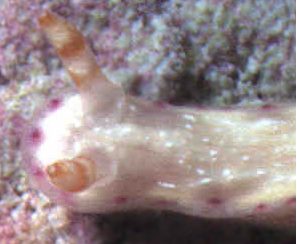
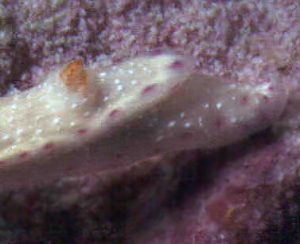
Dear Lindsay,
There are a number of species with this general colour pattern, including Hypselodoris bertschi and H. maculosa. Only H. maculosa can have the three reddish bands on the rhinophore clubs, but the white specks and faint brown lines all over the dorsum don't really fit. One possibility is the animal I have been calling Hypselodoris cf. carnea. If you have a look at the photos of animals from New South Wales you can see it can have 3 bands on the rhinophore clubs and has thin alternating brown and white longitudinal lines. If the white lines were broken into spots they would be very like this animal from Sulawesi.
But basically we would need some more material, intermediates and some anatomy before we could say anything sensible
Best wishes,
Bill Rudman
Hypselodoris from Enewetak Atoll
March 25, 2000
From: Scott Johnson
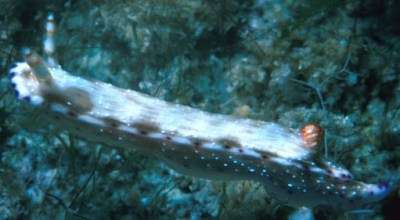
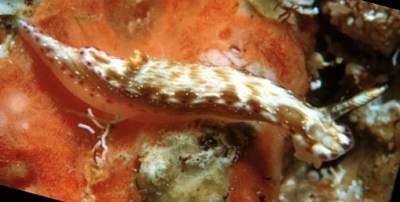
Bill,
After submitting all those Hawaiian Hypselodoris that are decorated with longitudinal white streaks, [see C. decora Colour Group] it seems appropriate to add one more that so far I've found only here in the Marshall Islands. This species [my Hypselodoris sp. E063] is similar in size to H. peasei and H. violabranchia. See further photos above. It has deep purple spots around the margins, particularly around the anterior and posterior ends and on the tail. Its most characteristic feature, however, is scattering of small white granules (glands?) over the mantle and sides of the foot.
Scott
johnson@kmr.ll.mit.edu
Johnson, S., 2000 (Mar 25) Hypselodoris from Enewetak Atoll. [Message in] Sea Slug Forum. Australian Museum, Sydney. Available from http://www.seaslugforum.net/find/1872Dear Scott,
If this is a distinct species, which it certainly seems to be, this group of similarly coloured species is certainly becoming a bit difficult to sort out.
Bill Rudman.
Reference: •Gosliner, T.M. & Johnson, R.F. (1999) Phylogeny of Hypselodoris (Nudibranchia: Chromodorididae) with a review of the monophyletic clade of Indo-Pacific species, including descriptions of twelve new species. Zoological Journal of the Linnean Society, 125: 1-114.
Rudman, W.B., 2000 (Mar 25). Comment on Hypselodoris from Enewetak Atoll by Scott Johnson. [Message in] Sea Slug Forum. Australian Museum, Sydney. Available from http://www.seaslugforum.net/find/1872